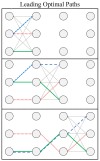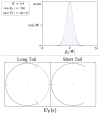Gaussian Amplitude Amplification for Quantum Pathfinding
- PMID: 35885186
- PMCID: PMC9322941
- DOI: 10.3390/e24070963
Gaussian Amplitude Amplification for Quantum Pathfinding
Abstract
We study an oracle operation, along with its circuit design, which combined with the Grover diffusion operator boosts the probability of finding the minimum or maximum solutions on a weighted directed graph. We focus on the geometry of sequentially connected bipartite graphs, which naturally gives rise to solution spaces describable by Gaussian distributions. We then demonstrate how an oracle that encodes these distributions can be used to solve for the optimal path via amplitude amplification. And finally, we explore the degree to which this algorithm is capable of solving cases that are generated using randomized weights, as well as a theoretical application for solving the Traveling Salesman problem.
Keywords: amplitude amplification; quantum algorithms; quantum computing.
Conflict of interest statement
The authors declare no conflict of interest.
Figures































References
-
- Grover L.K. A fast quantum mechanical algorithm for database search. arXiv. 19969605043
-
- Bennett C.H., Bernstein E., Brassard G., Vazirani U. Strengths and Weaknesses of Quantum Computing. Siam J. Comput. 1997;26:1510–1523. doi: 10.1137/S0097539796300933. - DOI
-
- Farhi E., Gutmann S. Analog analogue of a digital quantum computation. Phys. Rev. A. 1998;57:2403. doi: 10.1103/PhysRevA.57.2403. - DOI
-
- Brassard G., Hoyer P., Tapp A. Quantum Counting; Proceedings of the LNCS 1443: 25th International Colloquium on Automata, Languages, and Programming (ICALP); Aalborg, Denmark. 13–17 July 1998; pp. 820–831.
LinkOut - more resources
Full Text Sources

